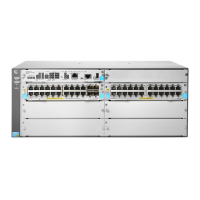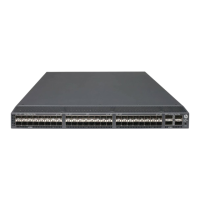33
Figure 8 Broken fiber
As shown in Figure 8, Device and Device B are connected through an optical fiber. After you
enable DLDP, Port 1 and Port 2 establish the bidirectional neighborship in the following way:
a. Port 1 that is physically up enters the Unidirectional state and sends a RecoverProbe
packet.
b. After receiving the RecoverProbe packet, Port 2 returns a RecoverEcho packet.
c. After Port 1 receives the RecoverEcho packet and detects that the neighbor information in
the packet matches the local information, Port 1 establishes the neighborship with Port 2
and transits to the Bidirectional state. Port 1 then starts the Entry timer and periodically
sends Advertisement packets.
d. After Port 2 receives the Advertisement packet, it establishes the Unconfirmed neighborship
with Port 1. Port 2 then starts the Echo timer and Probe timer, and periodically sends Probe
packets.
e. After receiving the Probe packet, Port 1 returns an Echo packet.
f. After Port 2 receives the Echo packet and detects that the neighbor information in the
packet matches the local information, the neighbor state of Port 1 becomes Confirmed. Port
2 then transits to the Bidirectional state, starts the Entry timer, and periodically sends
Advertisement packets.
The bidirectional neighborship between Port 1 and Port 2 is now established.
After that, when Port 2's Rx end fails to receive signals, Port 2 is physically down and enters the
Inactive state. Because Port 2's Tx end can still send signals to Port 1, Port 1 stays up. After the
Entry timer for Port 2 expires, Port 1 starts the Enhanced timer and Echo timer, and sends a
probe packet to Port 2. Because Port 1's Tx line is broken, Port 1 cannot receive the Echo
packet from Port 2 after the Echo timer expires. Port 1 then enters the Unidirectional state, and
sends a Disable packet to Port 2. At the same time, Port 1 deletes the neighborship with Port 2,
and starts the RecoverProbe timer. Port 2 stays in Inactive state during this process.
Detecting multiple neighbors
When multiple devices are connected through a hub, enable DLDP on all interfaces connected to the
hub to detect unidirectional links among the neighbors. When no Confirmed neighbor exists, an
interface enters the Unidirectional state.
Port 1 Port 2
Ethernet
fiber port
Fiber link
Device A Device B
Broken fiber
Port 1 Port 2
Device A Device B
Correct fiber
connection
One fiber is
broken
Tx end Rx end

